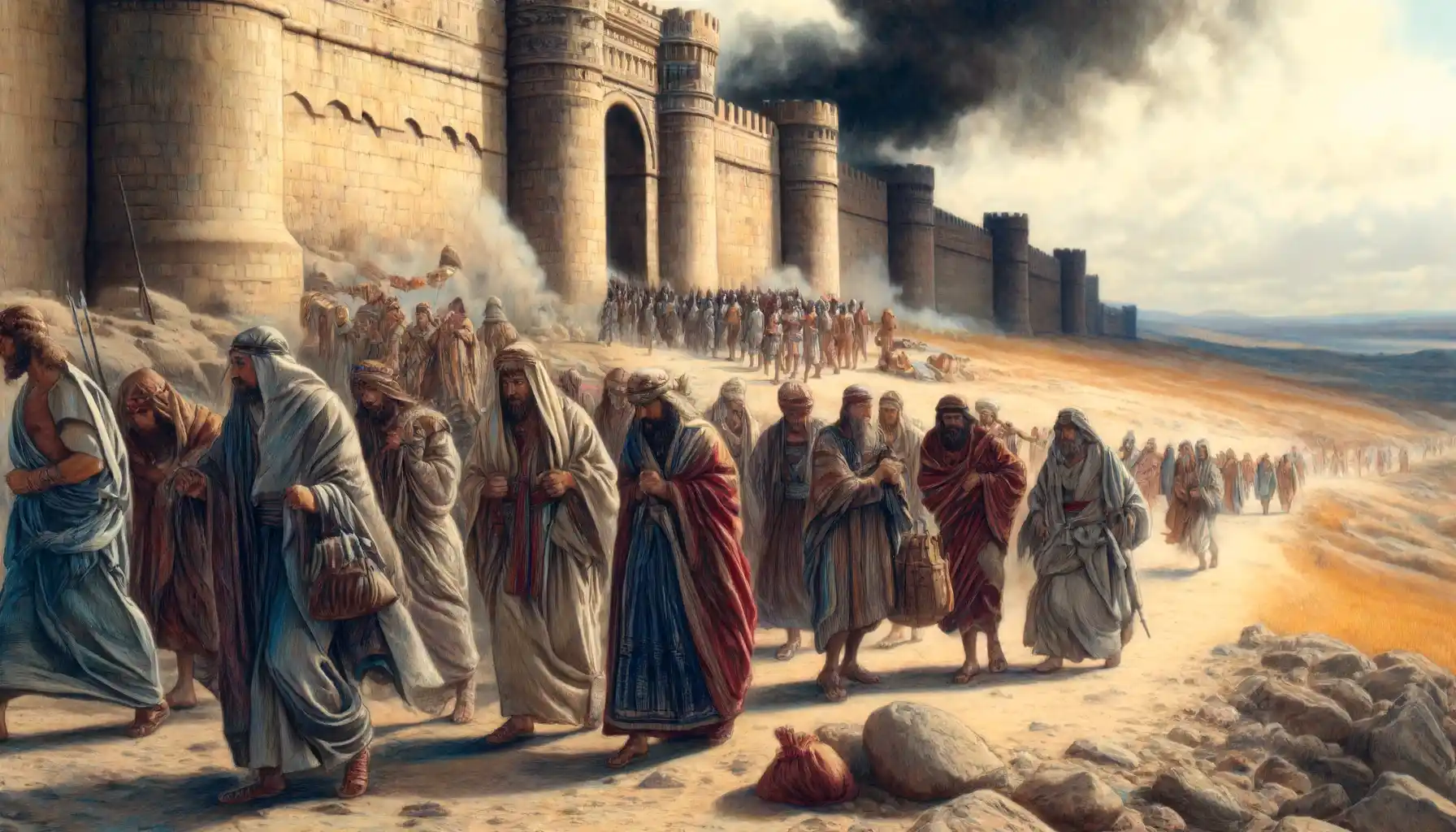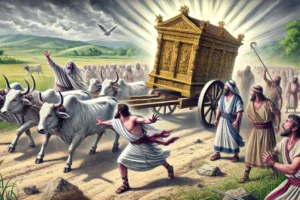
The Exile of Judah
The Exile of Judah, as detailed in 2 Kings 25:1-21, marks the end of the Kingdom of Judah and the beginning of the Babylonian Captivity. This event was a culmination of a series of invasions and a significant turning point in Jewish history, resulting in the destruction of Jerusalem and the Temple.
Quick Facts:
- Siege of Jerusalem: King Nebuchadnezzar of Babylon laid siege to Jerusalem in the ninth year of King Zedekiah’s reign, lasting until the eleventh year (2 Kings 25:1-2).
- Famine in the City: The prolonged siege led to a severe famine in Jerusalem, causing great suffering among the inhabitants (2 Kings 25:3).
- Breach of the City Walls: On the ninth day of the fourth month, the city walls were breached, and the Babylonian army entered Jerusalem (2 Kings 25:4).
- Escape and Capture of Zedekiah: King Zedekiah and his soldiers attempted to flee but were captured near Jericho. Zedekiah was taken to Riblah, where he witnessed the execution of his sons and was then blinded and taken to Babylon (2 Kings 25:4-7).
- Destruction of Jerusalem: Nebuzaradan, the commander of Nebuchadnezzar’s guard, burned the Temple, the king’s palace, and all the houses of Jerusalem (2 Kings 25:8-10).
- Demolition of the Walls: The walls surrounding Jerusalem were torn down by the Babylonian forces, leaving the city defenseless (2 Kings 25:10).
- Exile of the People: The remaining population, except for the poorest who were left to tend the vineyards and fields, were taken into exile in Babylon (2 Kings 25:11-12).
- Temple Treasures Taken: The Babylonians looted the Temple, taking all the valuable items made of gold, silver, and bronze back to Babylon (2 Kings 25:13-17).
- Execution of Leaders: Nebuzaradan captured and executed the chief priests, officers, and other prominent men of Judah at Riblah (2 Kings 25:18-21).
- End of the Kingdom of Judah: The fall of Jerusalem and the exile of its people marked the end of the Kingdom of Judah and the beginning of the Babylonian Captivity (2 Kings 25:21).
Context and Background: The Exile of Judah, detailed in 2 Kings 25:1-21, is a critical event in biblical history, marking the destruction of Jerusalem and the beginning of the Babylonian Captivity. This period represents the fulfillment of prophetic warnings due to the persistent unfaithfulness and disobedience of Judah’s kings and people.
1. The Siege of Jerusalem: The siege began in the ninth year of King Zedekiah’s reign, when Nebuchadnezzar, King of Babylon, laid siege to Jerusalem. This military action lasted approximately eighteen months, from the tenth month of the ninth year to the fourth month of the eleventh year of Zedekiah’s reign (2 Kings 25:1-2). The protracted siege caused severe hardship and famine within the city, weakening the inhabitants and the city’s defenses.
2. Famine and Breach: The famine became so severe that there was no food for the people, leading to extreme suffering and desperation (2 Kings 25:3). The breach of the city walls on the ninth day of the fourth month was a significant turning point, as it allowed the Babylonian forces to enter and capture Jerusalem (2 Kings 25:4).
3. Capture of Zedekiah: King Zedekiah, along with his soldiers, attempted to escape but were captured near Jericho (2 Kings 25:4-5). Zedekiah was brought to Riblah to face Nebuchadnezzar. There, he witnessed the execution of his sons before being blinded and taken in chains to Babylon (2 Kings 25:6-7). This act was symbolic of the total dismantling of Judah’s royal line and the humiliation of its king.
4. Destruction of Jerusalem: Nebuzaradan, the commander of Nebuchadnezzar’s guard, was ordered to destroy the city. He burned down the Temple, the royal palace, and all the significant houses in Jerusalem (2 Kings 25:8-9). This destruction signified the loss of the central place of worship and the administrative heart of the nation, symbolizing the end of the Kingdom of Judah.
5. Demolition of the Walls: The Babylonian forces demolished the walls surrounding Jerusalem (2 Kings 25:10). This act rendered the city defenseless and marked the total subjugation and desolation of Jerusalem.
6. Exile of the People: The Babylonian forces deported the remaining population, leaving behind only the poorest of the land to tend to the vineyards and fields (2 Kings 25:11-12). This mass exile was a fulfillment of the warnings given by prophets like Jeremiah and signaled a significant shift in the lives of the Jewish people.
7. Looting of the Temple: The Babylonians looted the Temple, taking valuable items made of gold, silver, and bronze back to Babylon (2 Kings 25:13-17). The removal of these sacred objects was a profound loss for the Jewish people, as these items held religious and cultural significance.
8. Execution of Leaders: Nebuzaradan captured and executed key leaders, including priests, officers, and other prominent men of Judah, at Riblah (2 Kings 25:18-21). This act further decapitated the societal and religious structure of Judah, leaving the nation leaderless and in disarray.
9. End of the Kingdom of Judah: The fall of Jerusalem and the subsequent exile marked the end of the Kingdom of Judah (2 Kings 25:21). This event is seen as a divine judgment for the nation’s persistent idolatry and disobedience. The exile was a period of great suffering but also one of reflection and eventual renewal for the Jewish people.
Theological Insights:
Divine Judgment and Prophecy Fulfillment: The events leading to the exile were prophesied by several prophets, including Isaiah and Jeremiah, who warned of the consequences of Judah’s unfaithfulness. The destruction and exile are seen as the fulfillment of these divine warnings, underscoring the seriousness of covenantal disobedience.
Loss and Hope: While the destruction of Jerusalem and the Temple was devastating, it also set the stage for a renewed focus on faith and identity. The exile became a period of profound theological reflection, leading to the eventual return and restoration under leaders like Ezra and Nehemiah.
Covenantal Faithfulness: The exile highlighted the importance of faithfulness to God’s covenant. The Jewish people’s experience in Babylon reinforced the need for obedience and the consequences of turning away from God.
Conclusion: The Exile of Judah as described in 2 Kings 25:1-21 is a somber narrative of destruction, loss, and divine judgment. It marked the end of an era for the Kingdom of Judah but also the beginning of a new chapter in Jewish history. This event serves as a powerful reminder of the importance of faithfulness to God and the enduring hope for restoration and renewal even in the face of judgment and exile.



